Project 1: Ephemeral, Site and Social Space
“The Source”
At the center is a singular nut symbolizing the source of life. The surrounding circles highlight objects found in the environment: other nuts, oranges, leaves, and sediment. All of these serve as indicators of a carefully designed space that suggests comfort and relief. There are trees that produce fruit and cast shade over tables, creating a setting suitable for eating and resting. Although such fruit-bearing trees are not typically part of Arizona's agriculture, they serve a dual purpose: providing shade from the sun and offering oranges as nourishment. The tables are artificial objects that give people a place to rest and leave their belongings. In America, female trees are often minimized to support a capitalist structure. Consequently, this environment turns the natural act of eating and resting into an artificial, designed space. The empty chairs and tables invite visitors to relax, yet they also turn what nature offers into a visual backdrop. The vibrant colors of the oranges and seeds attract people to this piece. This serves as an invitation to question the importance of artificial objects in natural spaces. The orientation of both the arrangement and the tables are artificial, but one is derived from the natural environment and the other is not. The arrangement of gathered resources peels back the designed space, bringing its unique purpose and importance to the forefront in a way that the artificially designed objects cannot.
Process
Materials:
Canon EOS M
iPhone
Sketchbook
Hands!
Setting:
This is a walkway that I encountered a lot on walks to class. This shaded passage is known for producing oranges, providing shade, and a seating area. It stands out from the urban environment and provides a place of serenity and comfort before the tram arrives. Its spatial uniqueness resonated with me, and I knew I wanted my project to take place here.
Step 1: Survey (1:30 PM)
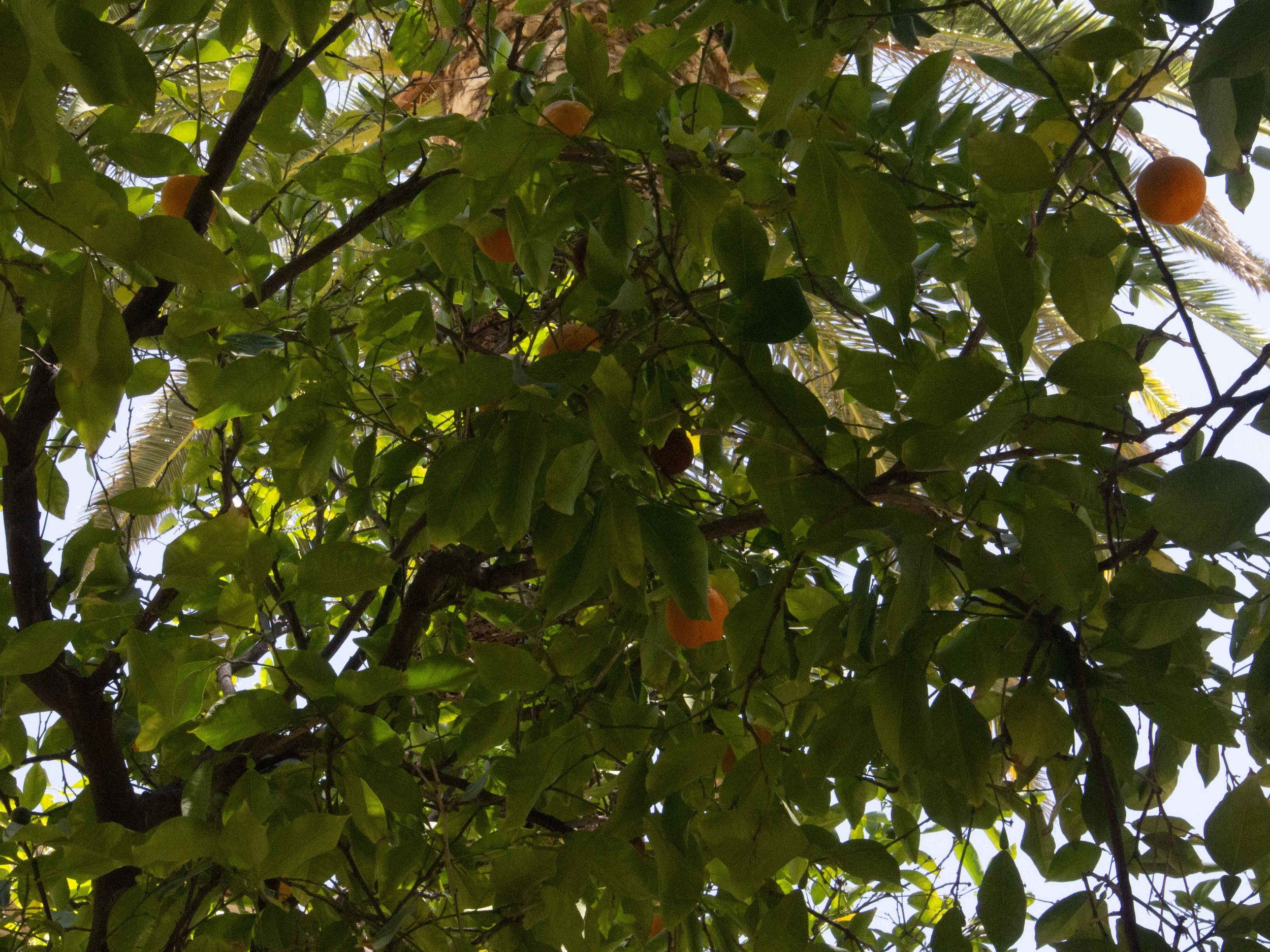
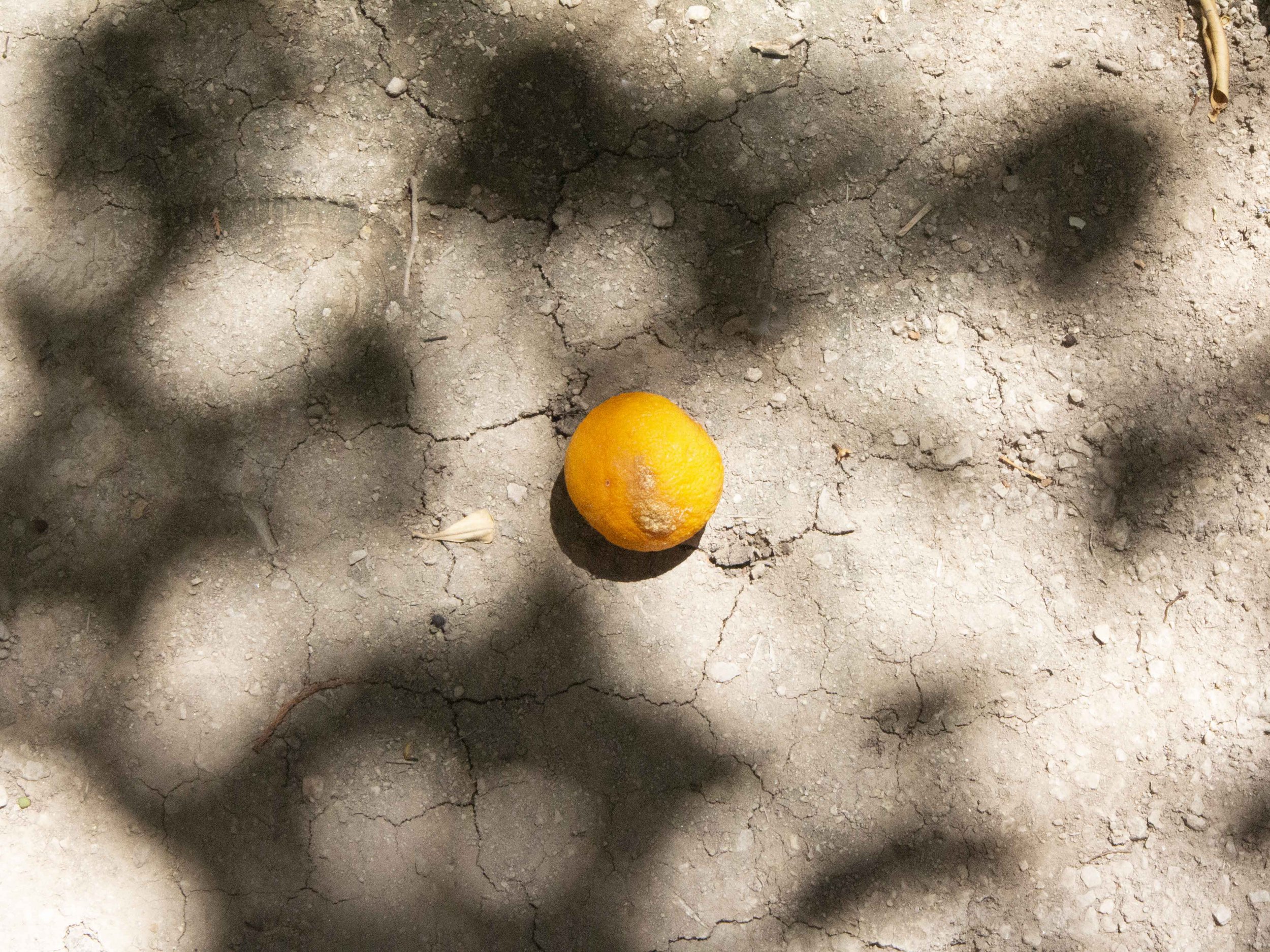
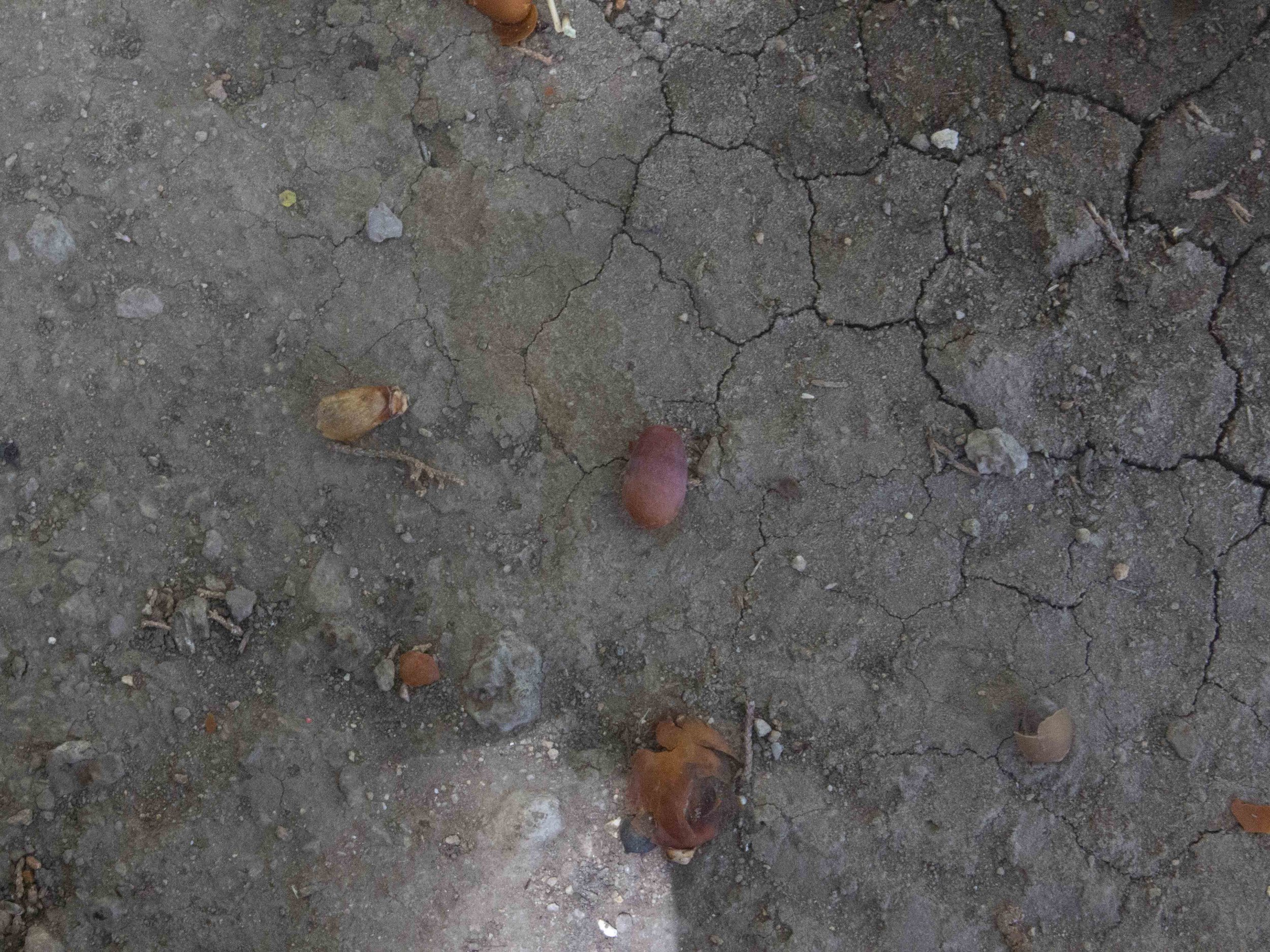
Peering through the trees, I see vibrant oranges growing. On the ground, some oranges were bruised, sunburnt, and spoiled. There were even some that were premature and hard as rocks. This made me think about the weight of oranges before they drop and how long it takes a single orange to grow.
Back in Georgia, at my grandma’s house, I remember eating an orange. Oranges were my favorite because they were the only fruit I ever ate and enjoyed. I’m sure I was still traumatized from having strawberries shoved in my mouth and throwing up at daycare, but we don’t need to get into that right now! Whilst enjoying my delicious orange, I got the idea to go into the front yard and plant an orange seed just outside the door. I dug my little fingers into the sand about 1 to 2 inches and placed it carefully into the ground. I filled it back up with sand and forgot about it. The only time it came to mind was when I was away from her house. I had this false hope that I’d see it budding, even though I didn’t tell my grandma it was there so she’d water it. Now and then, I think about that seed and whether or not it’s still there or bird poop.
Anyway, I also took note of the nuts I found around the base of the trees. I couldn’t link them to a particular plant in the area, so I just assume it’s from the tree somehow, even though they don’t look like orange seeds I’m familiar with. Wait, are nuts seeds? I’m sure these are seeds, and they look pretty edible, which goes back to my original idea. There were also dead leaves around, which would further communicate the existence of orange trees in the area. Essentially, I wanted my piece to be derivative of the objects I found in the area and expand upon the space’s intended purpose.
Step 2: Composition Planning (1:45 PM)


While I was assembling what I wanted to use, I did quick sketches on how I wanted the final project to look. Immediately, I thought of mimicking the circular shape of the white tables to bring them both into conversation. The earthy vibe that the arrangement would create would juxtapose the cleanish orientation of the tables. This would make the piece commentate on whether or not design objects are needed in natural environments to demonstrate what they’re used for. Nature already provides places of rest, but our attachment to convenient objects makes us dependent on design objects to clarify a space.
Step 3: Assembling (1:52 PM)
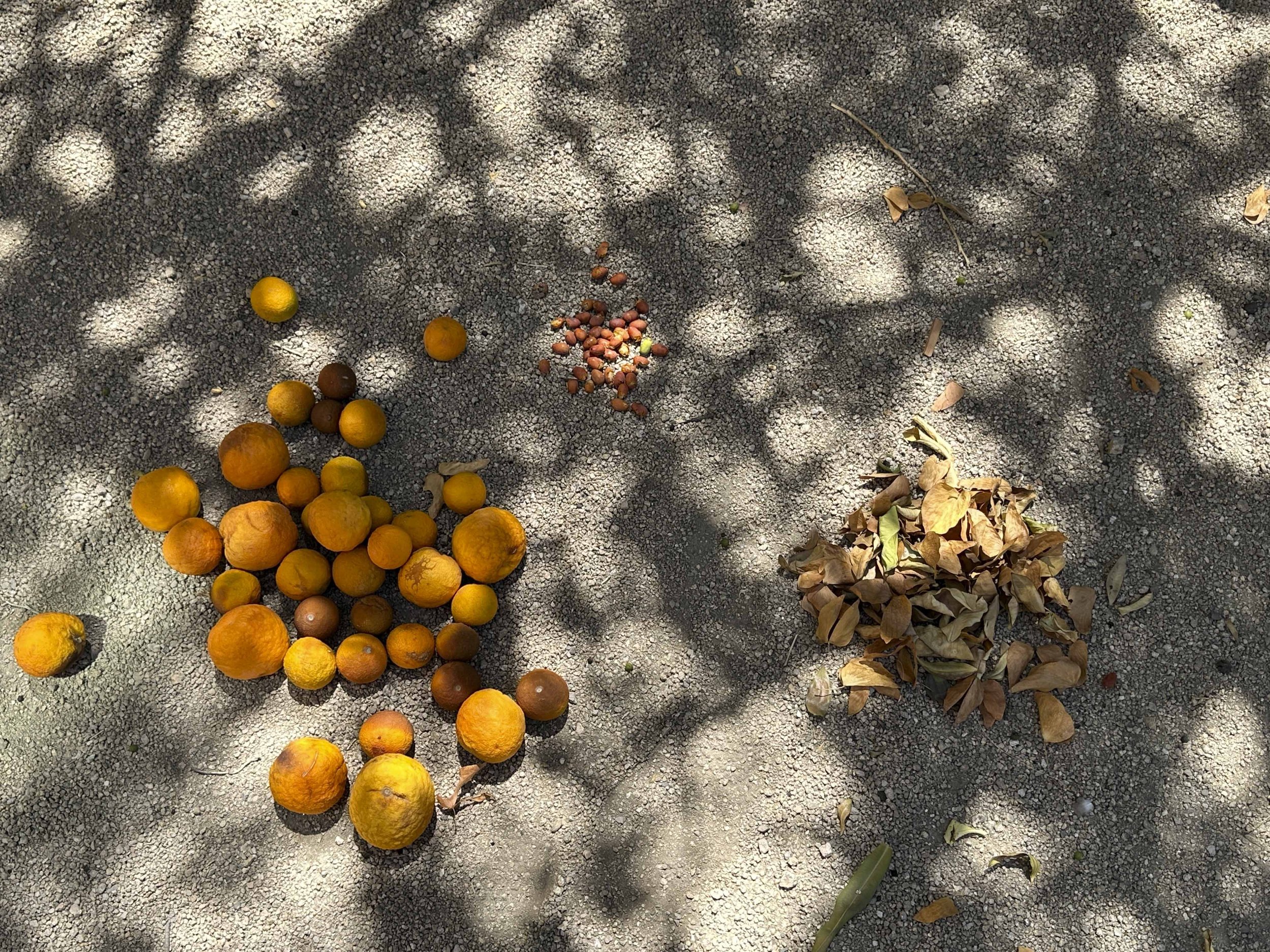
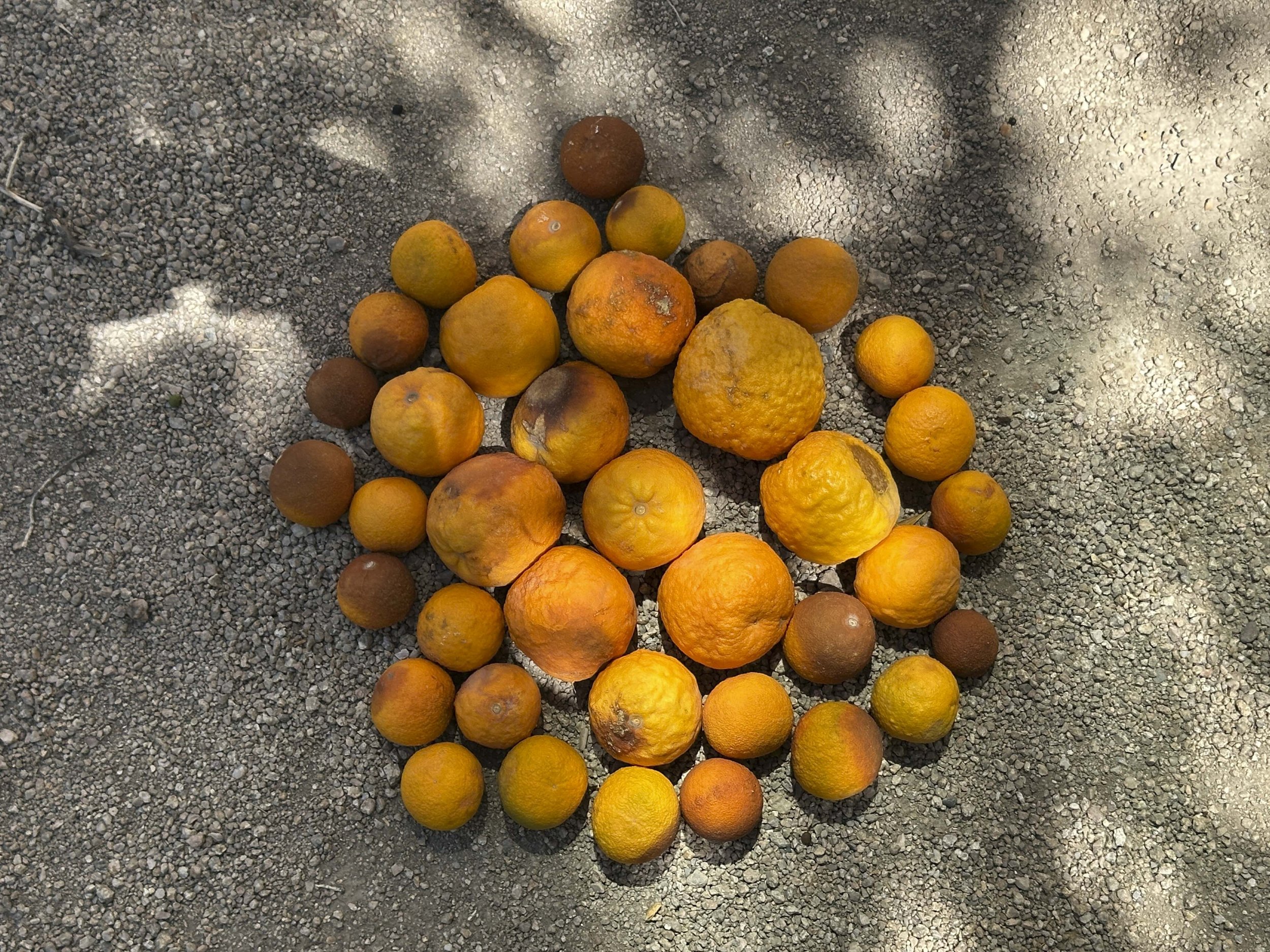
There were a lot of people walking back and forth through the process of organizing the piece. First, I gathered the oranges. Then, the nuts and leaves. And finally, the dirt which is everywhere (definitely, was all over me by the time I was done.) Originally, I collected all of the oranges in the area, but then I threw the ones that were the most rotten, moldy, and unappealing off to the side.
As you can see in the second picture, I pushed the oranges into a tight circle. I didn’t take progress photos throughout the building process; I regret it. While I was working on it, my brain shut off for the most part. Everything kind of came to me naturally. Initially, I was hesitant to get my hands dirty, but I became more comfortable with the sediment. “Dirt don’t hurt,” as they say.
To get the ring shape, I parted the oranges to create a circular opening. In this space, I patted down the dirt to create a ridge between the oranges and where I would place the seeds. I placed the red seed along the ridge and placed a singular green nut in the middle to emphasize the point/center.
When I initially placed the leaves, they started to blow away. I remember Andy Goldsworthy’s Rivers and Tides sculptures always being destroyed by obsessive and repeating forms like the wind and water. The wind against these delicate leaves blew them away so easily. I lost about 15% of my leaves I gathered because of the wind blowing them back where I got them. To counteract this, I scooped dirt to the outer edge of the oranges and another ridge to create a dip to place the leaves within.
Finally, I started creating more rings by scooting my shoes and scooping and sculpting the dirt with my hands. I went on to create about three more rings. My favorite part is that you can see my footprints in the dirt. It serves as an index of a human presence, which adds a genuine energy to the piece.
Step 4: Finish (2:27 PM)
I kept sculpting and defining until I got to a place I was proud of. My favorite part of finishing up was taking out broken leaves, dried nuts, and tree remnants to make it look cleaner.
When I took my final pictures and walked away, I could only imagine it being destroyed. Then I realized that the centralization of nature isn’t a thing in society. People often design objects from a perspective that views nature as dirty or in the way. This undermines the natural value of nature and causes us to be isolated from it. Usually, I try to keep my artist statements somewhat vague and open-ended, but the message is about appreciating nature above everything else that mellows it.
Check In (8:09 PM)
I decided to go back later in the night to see if anything had changed. While I was walking back, my heart was racing because I wasn’t sure if something had happened to it. Luckily, there weren’t any big changes besides the wind blowing the leaves. I was going to fix it, but I decided it would be best if I just let it be. I think detachment from trying to obtain perfection can be healing because nothing stays the same forever. That’s the beauty of nature. I feel that without there being change every everything would be the same, a motionless, dull object. There can’t be life without change.







